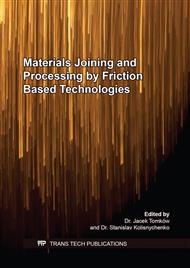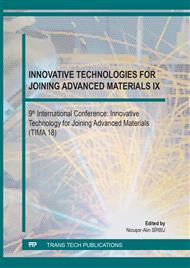p.1
p.7
p.16
p.21
p.27
p.36
p.46
p.52
Technical Characteristics of the Equipment for Friction Stir Welding (FSW), Depending on the Base Metals
Abstract:
There are various base metals that might be subjected to friction stir welding (FSW). They have different yield strength, ultimate tensile strength and other mechanical characteristics that influence the complex phenomena of the FSW process. The nature, mechanical characteristic and other properties of the base metals introduce also certain requirements for the FSW equipment, because FSW is a mechanical process.Experimental data of the FSW of the following materials are presented and compared:- similar overlapped sheets of aluminium alloy EN AW 5754, having the thickness 1.0 mm; - dissimilar overlapped sheets of 3 - 6 mm thickness of the base metal couples: aluminium alloy EN AW 1200 / copper Cu 99 ET, aluminium alloy EN AW 5754 / copper Cu 99, aluminium alloy EN AW 6082 / copper Cu 99 ET;- sheets of nickel alloy, inconel 718, thickness 8 - 10 mm, by friction stir processing. The characteristics of the FSW tool are described and the main technology parameters are mentioned: overlap, rotational speed of the FSW tool, rotational direction, travel speed, thrust force, as well as electric current of the motor for the rotating motion of the tool.Other important factors are also taken into account: sizes and positioning of the sheets (up or down), rolling direction of the sheets, room temperature, temperature of the sheets, material and temperature of the support plate.The linear energy of the FSW process is the main parameter. This is an indirect parameter, because it must be calculated, based on the previous mentioned parameters. According to the definition, the linear energy depends directly on the mechanical power developed during the stirring process, respectively it depends indirectly on the travel speed.On the other hand, the heat input is directly proportional to the linear energy and the thermal efficiency of the transfer of the heat produced by the friction of the shoulder and pin, to the nugget zone, where the weld metal is produced. These quantities are also analysed.For these materials the power developed by the motor for the rotational movement is determined, as well as the mechanical torque applied to the FSW tool. All these data are important for the design of the FSW equipment, in order to realize its main technical characteristics, depending on the base metals.Conclusions on the results are exposed, with important consequences for the industrial applications of the FSW process.
Info:
Periodical:
Pages:
7-15
Citation:
Online since:
May 2019
Authors:
Price:
Сopyright:
© 2019 Trans Tech Publications Ltd. All Rights Reserved
Share:
Citation:



